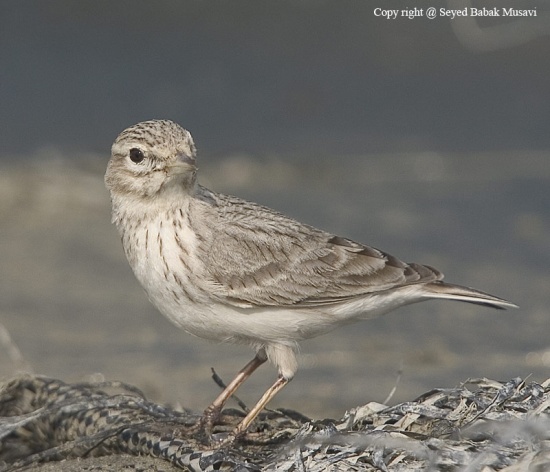(genus change (IOC and H&M)) |
|||
| (6 intermediate revisions by 3 users not shown) | |||
| Line 1: | Line 1: | ||
| − | + | {{incomplete}} | |
| − | [[Image:Indian_Short-toed_Lark.jpg|thumb|550px|right|Photo by Seyed Babak Mus]] | + | [[Image:Indian_Short-toed_Lark.jpg|thumb|550px|right|Photo by {{user|Seyed+Babak+Mus|Seyed Babak Mus}}<br />Location: Near the shore in Soorgalm Creek]] |
| + | '''Alternative name: Indian Short-toed Lark''' | ||
| + | ;[[:Category:Alaudala|Alaudala]] raytal | ||
| + | ''Calandrella raytal'' | ||
==Identification== | ==Identification== | ||
| − | + | 13cm. Greyish sandy, with dark brown streaks, from above, while the belly is white, sparsely and indistinctly dark-streaked on the sides. Supercilium and cheeks are white. Shortish black and white tail. Sexes alike. | |
| − | + | ==Distribution== | |
| − | + | [[India]]. | |
| − | + | ==Taxonomy== | |
| − | + | Placed in genus ''[[:Category:Calandrella|Calandrella]]'' by Clements. | |
| − | + | ==Habitat== | |
| − | + | ==Behaviour== | |
| − | + | Diet includes weed, seeds and insects. | |
| − | |||
| − | |||
| − | |||
| − | |||
| − | |||
| − | |||
| − | [ | ||
| − | |||
| − | |||
| − | |||
| − | |||
| − | |||
| − | |||
| − | |||
| − | [ | ||
| − | |||
| − | |||
| − | |||
| − | |||
| − | |||
| + | Nesting Season: February to May. Nest: A cup like depression in the ground at the base of a shrub, lined with grass, hair, etc. Eggs: 3, sometimes 2. Yellowish or greyish white, freckled with brown. Both sexes share domestic chores. | ||
==External Links== | ==External Links== | ||
| − | + | {{GSearch|Lark+raytal}} | |
| − | [[Category: | + | [[Category:Birds]][[Category:Alaudala]] |
Revision as of 11:44, 12 September 2015
| This article is incomplete. This article is missing one or more sections. You can help the BirdForum Opus by expanding it. |
Alternative name: Indian Short-toed Lark
- Alaudala raytal
Calandrella raytal
Identification
13cm. Greyish sandy, with dark brown streaks, from above, while the belly is white, sparsely and indistinctly dark-streaked on the sides. Supercilium and cheeks are white. Shortish black and white tail. Sexes alike.
Distribution
Taxonomy
Placed in genus Calandrella by Clements.
Habitat
Behaviour
Diet includes weed, seeds and insects.
Nesting Season: February to May. Nest: A cup like depression in the ground at the base of a shrub, lined with grass, hair, etc. Eggs: 3, sometimes 2. Yellowish or greyish white, freckled with brown. Both sexes share domestic chores.




